Variegated Alocasia Macrorrhiza Variegata Albo: Elephant Ear Plant
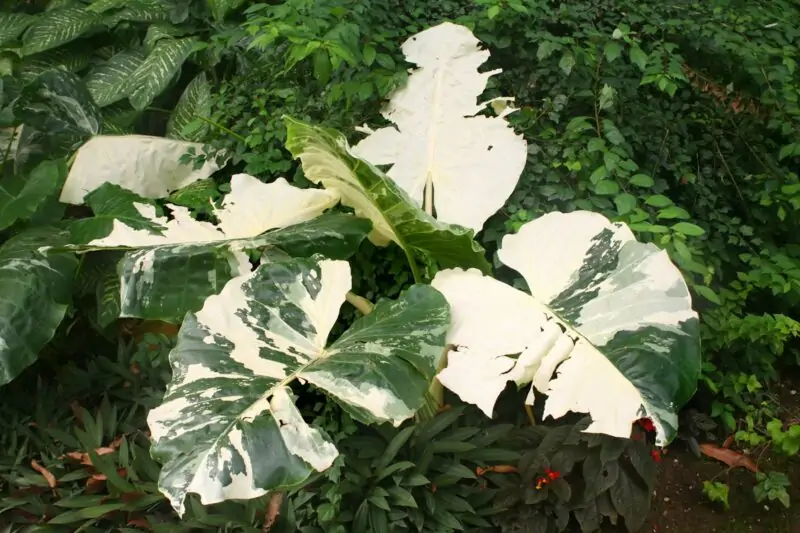
Are you looking for a unique and stunning houseplant to add some shine to your living space? Look no further than Alocasia Macrorrhiza Variegata, commonly known as elephant ear plant. With its glossy green and white leaves, this tropical plant is sure to turn heads wherever it’s displayed.
In this article, we’ll explore everything you need to know about caring for Alocasia plants. From ideal light conditions and watering techniques to potting tips and propagation methods for your mature plants – we’ve got you covered! So let’s dive into the world of this fascinating foliage.
A Brief Overview of Alocasia Macrorrhiza Variegata Albo
Alocasia macrorrhiza variegata is a tropical perennial belonging to the family Araceae. It is native to Southeast Asia and eastern Australia, growing wild in moist forested areas near streams or ponds where they can get high humidity levels with indirect light exposure (not too much direct sunlight). They are commonly grown indoors as ornamental houseplants due to their striking appearance with large shiny variegated leaves featuring abstract patterns of green intermingled with white stripes on top while underneath show off shades ranging from purple-brown hues through lighter greens bordering yellow undertones.
While you typically buy this plant from your local nursery in a 6 inch pot, as your alocasia grows, it will need room to grow both vertically and horizontally: replanting is really a must for your Alocasia.
The Importance of This Rare Elephant Ear Plant
The Elephant Ear Plant has been widely cultivated by many growers worldwide due to its natural appeal and adaptability, making them versatile plants perfect for adding interest to any setting. One of the most spectacular plants ever with leaves covered in white blotches, your Elephant Ear Plant will be a perfect centerpiece for indoor or outdoor spaces alike!
Their popularity stems partially because they are relatively easy to grow even in less-than-ideal conditions; however, growing these beauties does require certain steps to be taken to ensure healthy growth. Proper lighting, fertility management, and providing an adequate environment like soil moisture content and the presence of airflow around the plant – all these are things to keep in mind when considering purchasing one for yourself!
Characteristics of Alocasia Macrorrhiza Variegata
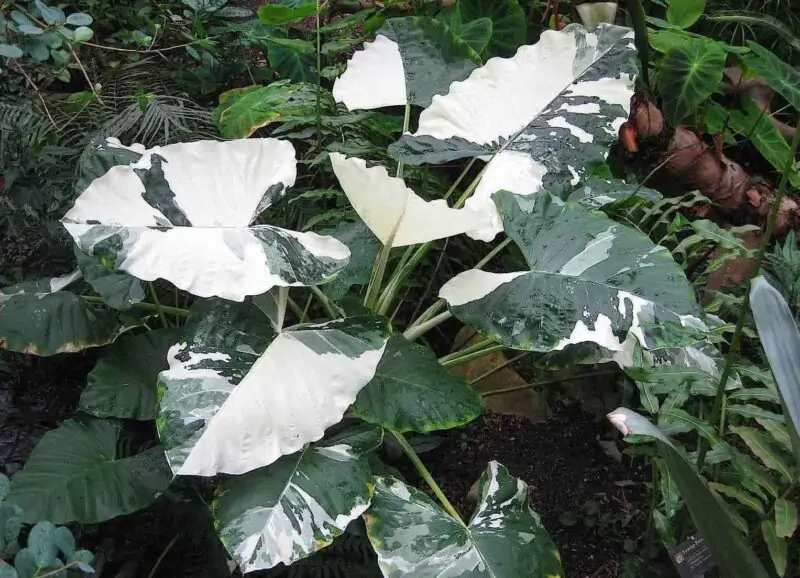
Unique Variegated Foliage
One of the most striking characteristics of Alocasia Macrorrhiza Variegata is its foliage, which features a unique variegated pattern. The glossy leaves which are mostly green are adorned with white stripes and patches that create an eye-catching abstract design.
Color Patterns and Variations
Although the base color of the plant’s leaves is typically green, there can be variations in shades ranging from lighter greens to darker hues bordering on purple-brown tones underneath, depending on their age or other factors such as nutrient availability and light exposure.
Leaf Shape and Structure
The leaf shape resembles an elephant ear (hence one common name), measuring up to 6-8 inches wide at maturity. They have very long petioles – stem-like structures attaching them to the main stalks, giving rise to graceful movement in the slightest breeze!
Growth and Size
Alocasia mycorrhizas grow relatively fast as a species but do slow down once they reach maturity – usually after around two years since planting in the soil or potting mixtures, indoors or in container gardens alike! These plants range in height between 2′ – 4′ and spread about the same distance, making them ideal focal points for larger areas like living rooms, entryways, or outdoor landscaping options.
Typical Growth Rate
The typical growth rate for Alocasia mycorrhizas ranges anywhere from half an inch per week during optimal growing conditions up to several inches within just a month alone, provided enough environmental support is consistently applied throughout the year. This makes it a great choice for those looking for a plant that adds visual interest quickly and enhances space without taking forever to get established and mature fully.
Maximum Height And Spread
At full maturation, this Elephant Ear Plant can stand between four to six feet tall while having a maximum width spanning approximately 3 to 4 feet across. These dimensions result in a large plant that is sure to make a statement wherever it’s grown.
Flowering and Fragrance
The Alocasia Macrorrhiza Variegata does produce flowers, but the inflorescence structure is not particularly ornamental when compared to its striking foliage. The scent profile of these plants is known for their subtle earthy fragrance that emanates from their leaves and stems.
Caring for Variegated Alocasia Macrorrhiza
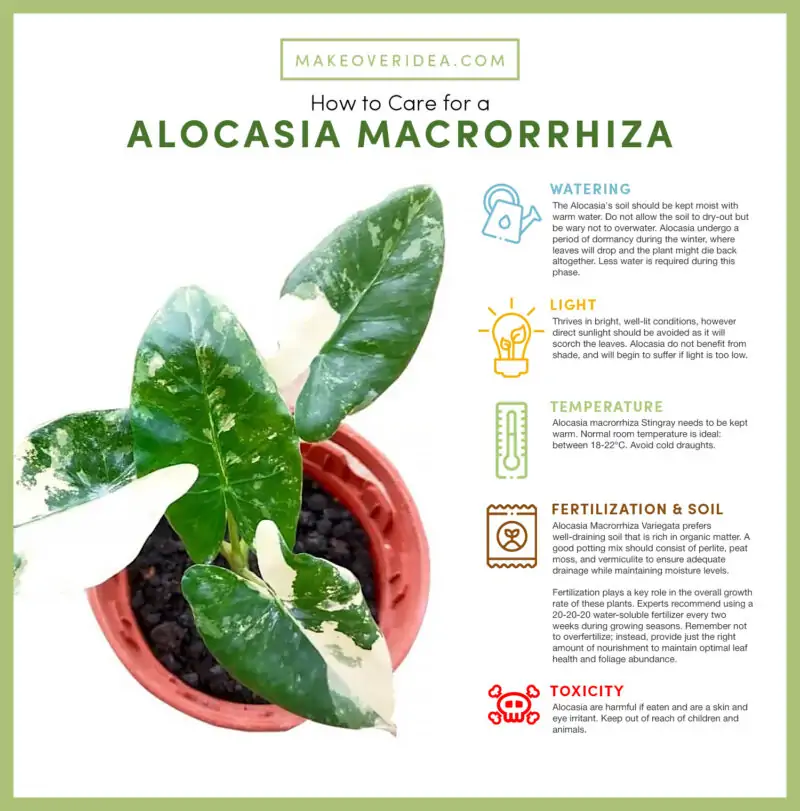
Now let’s dive into the key factors you need to consider when caring for your variegated elephant ear plant.
Light Requirements
Ideal light conditions can be tricky with these spectacular houseplants because they require indirect bright but indirect light exposure. Direct sunlight causes major issues like leaf burn over time leading to health problems later on: keep your plant away from full sun. For optimal growth rates and healthy development, place them near window screens or areas where there’s plenty of natural light without any harsh rays contributing to heat, as these house plants prefer warm and well-lit but not very hot environments. You can also use artificial lights as backup sources depending on individual preferences, climate, and location.
Watering and Humidity
Alocasias thrive best in moist soil environments, making water one of the most important elements of care. Plants should typically be watered once every week during growing seasons (Spring-Summer). Cutting back frequency by half during non-growing months when watering needs are reduced (Fall-Winter). Apply heavier amounts of water at longer intervals, and ensure proper drainage to avoid root rotting and other complications.
Maintaining optimal humidity levels will ensure strong growth patterns and give rise to lush foliage. To increase moisture in the surrounding environment, mist frequently using spray bottles filled with pure clean tap, distilled, or rainwater.
Soil and Fertilizer
Alocasia Macrorrhiza Variegata prefers well-draining soil that is rich in organic matter. A good potting mix should consist of perlite, peat moss, and vermiculite to ensure adequate drainage while maintaining moisture levels.
Fertilization plays a key role in the overall growth rate of these plants. Experts recommend using a 20-20-20 water-soluble fertilizer every two weeks during growing seasons. Remember not to overfertilize; instead, provide just the right amount of nourishment to maintain optimal leaf health and foliage abundance.
Temperature and Climate
Ideal temperature ranges for variegated elephant ear plants are between 65°F to 85°F (18°C to 29°C). They prefer warmer climates but can tolerate cooler temperatures if they are kept dry with minimal watering throughout winter months when active growth slows down considerably.
Potting and Repotting Alocasia Macrorrhiza Variegata
Choosing the appropriate pot size is crucial for ensuring healthy root development and overall plant performance. Factors such as space availability, aesthetics, durability, and weight considerations play a determining factor in selecting the correct containers for housing the plant.
Report your variegated elephant ear every one to three years, depending on the size of the container and whether it is grown indoors or outdoors. Staying on top of pest control and maintenance habits will also help limit the likelihood of infestations.
When it comes time to repot your plant, follow these easy steps:
- Choose a pot that is one size larger than your current container.
- Fill the new pot with fresh, well-draining soil mix.
- Carefully remove your plant from its old container and loosen any tangled roots.
- Place the plant in its new pot and fill it up to about an inch below the rim of the planter with more soil mixture added as necessary.
- Water heavily immediately after transplanting.
Pruning and Propagation of Variegated Alocasia
Pruning and propagation are essential tasks when it comes to maintaining and expanding your collection of variegated Alocasia.
Pruning
Regular pruning helps maintain the plant’s shape, size, and health. It also encourages new growth and removes any diseased or damaged foliage. Follow these guidelines for pruning your variegated Alocasia:
- Use clean, sharp pruning shears or scissors to avoid introducing diseases or pests.
- Remove any yellowing, wilting, or damaged leaves by cutting at the base of the stem.
- Trim away any dead or dying flower stalks.
- If the plant becomes too large, you can also selectively remove some healthy leaves to reduce its size. However, be cautious not to remove too many leaves at once, as this may stress the plant.
Prune your variegated Alocasia as needed throughout the year, with more attention paid during the growing season.
Propagation
Propagating variegated Alocasia is typically done by division, allowing you to create new plants from your existing ones. The best time to propagate is during the repotting process, usually in early spring. Follow these steps for successful propagation:
- Carefully remove the parent plant from its pot and shake off any excess soil.
- Examine the root system to identify any offsets or smaller plantlets growing near the base of the main plant.
- Using a clean, sharp knife or pruning shears, gently separate the offset from the parent plant, ensuring that each new division has a healthy root system and at least one or two leaves.
- Plant each division in its own pot filled with fresh, well-draining soil mix.
- Water the new divisions thoroughly, and keep the soil consistently moist during the first few weeks to encourage root development.
Place the newly propagated plants in a warm, bright location, avoiding direct sunlight. Once the new plants are well-established and showing signs of active growth, care for them as you would the parent plant.
Common Problems and Solutions
As with any houseplant or garden ornamental, Alocasia Macrorrhiza Variegata is susceptible to several common problems related to pests, diseases, or environmental factors. However, just like other tropical foliage plants, they are relatively easy for growers with moderate experience levels as long as certain precautions are taken into account.
Pests and Diseases
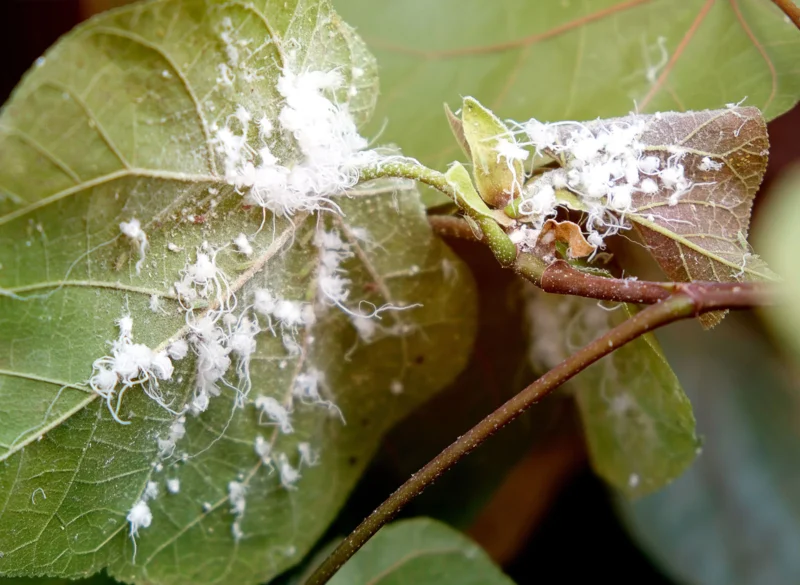
One of the biggest concerns when growing variegate elephant ears is insect infestations such as spider mites or mealybugs which usually appear due to lack of humidity inside homes during winter months when central heating dries out air excessively creating an ideal breeding ground for insects.
If left untreated these pests can cause serious damage by feeding on leaves leaving them yellowing desiccated and eventually destroying them completely leading also to stunted growth.
In addition, various fungal infections can occur that produce dark brown spots on leaves accompanied by wilting; this condition requires prompt treatment because it could lead to ultimately rotting roots affecting overall health status over longer periods being highly detrimental.
To prevent pest infestations from taking hold indoors ensure adequate humidity levels through methods such as using pebble trays filled with water close proximity to a suitable location near a light source. In outdoor locations avoid overcrowding planting schemes increasing airflow between individual specimens avoid watering at night make sure drainage holes properly function preventing standing pools excess water from contributing to rot formation.
Growing Issues And Remedies
Other common issues include leaf drooping caused mainly by under-watering situations or over-exposure to direct sunlight. If this happens make sure the soil is moist and plants placed in a more shaded location.
Yellowing leaves usually arise from lack of nutrition,so fertilizing at regular intervals could help remedy the situation; use a slow release organic fertilizer with balanced NPK ratios or specialized blends for foliage plants ensuring not to exceed recommended dosages.
Root rot is another common problem when too much water accumulates inside pot causing roots suffocating due excessive moisture, ultimately leading death. To avoid root rot provide adequate drainage holes that allow excess water escape, also ensure proper irrigation scheduling avoiding periods intense heat where watering routines need adjustments depending on external temperature conditions.
Toxicity Concerns For Humans And Pets
Though beautiful, variegated elephant ears are toxic if ingested by humans or pets. The plants contain calcium oxalate crystals, which can cause severe irritation of the mouth and throat as well as vomiting and diarrhea if consumed.
It’s best practice to keep variegated elephant ear plants out of reach of children and pets, such as dogs and cats, who may be tempted to chew on their attractive leaves. Warning signs indicating toxicity include swelling of the tongue, lips, and oral cavity, and difficulty breathing, among others.
If you suspect poisoning has occurred, seek medical attention immediately by contacting your veterinarian or hospital emergency room for advice. While it’s essential to take precautions around these stunning tropical beauties, they still remain highly sought after as indoor and garden favorites for those wishing to add a touch of exotic flair to their interiors and gardening spaces alike.
Using Variegated Alocasia In Your Home And Garden
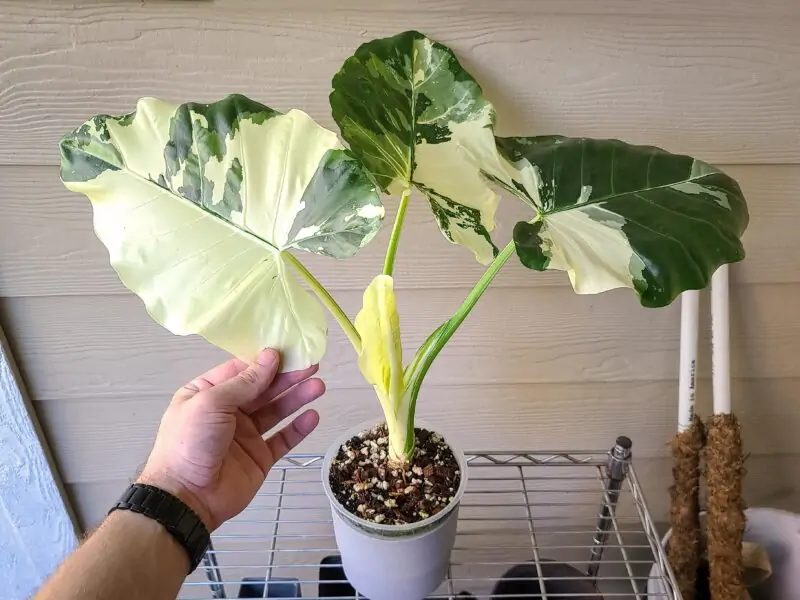
Alocasia Macrorrhiza Variegata’s unique glossy green-and-white variegation makes them ideal focal points in any home interior design scheme, especially in areas receiving indirect light sources. This characteristic makes them easy to maintain indoors through the correct care procedures outlined above.
For outdoor landscaping schemes, they work great with taller shrubs and trees, providing contrasting textures against darker evergreens and offering color contrast during winter months when everything else appears dull and dormant.
They are also great in mixed container planting arrangements combined with other tropical foliage plants such as Philodendron, Calathea, or Bird of Paradise, which all have similar care requirements.
For those wishing to create a more exotic vibe, try combining smaller Alocasia Macrorrhiza Variegata specimens with larger leafed elephant ear varieties like Colocasia Esculenta for an even more striking display. Creating height differences through pot stand placement can help draw attention to these beauties, providing added interest when viewed from varying angles.
FAQs
Identifying and Caring For Alocasia Macrorrhiza Variegata
Examine the leaves. If they exhibit a green-and-white variegation, then you have one.
These plants thrive in indirect light, humidity levels between 60-80%, well-draining soil with a pH range between 6.0 -6.5, and temperatures ranging between 18-25 degrees Celsius, which makes them an excellent choice for indoor houseplants.
Indoor vs Outdoor Growth Considerations
The answer depends on your personal preference. However, keep in mind that indoor growth requires proper lighting conditions, usually provided by artificial sources, and access to a water supply with sufficient moisture. Outdoor growth may require regular watering routines depending on weather patterns during the summer months. So, be sure to choose what works best for your individual needs.
Growth rate, size, and reviving struggling plants
The plant typically has an average annual growth rate of around half a meter tall and wide. However, factors including climate conditions, pot size, and fertilization practices affect overall size, so results vary widely.
Reviving struggling elephant ears could involve simple steps such as adjusting irrigation schedules, having enough drainage outlets, increasing humidity levels surrounding the plant, as well as fertilizing appropriately for optimal nutrition uptake.
Toxicity Information for Pets and Humans
Yes, this plant is toxic if ingested by humans and animals. Calcium oxalate crystals in the leaves, stems, and roots cause painful irritation, including swelling of the tongue, lips, and oral cavity, among others. It is advisable to keep these beautiful but dangerous houseplants out of reach of small hands and furry paws.
Conclusion
Variegated Alocasia Macrorrhiza Variegata is a stunning tropical foliage plant. With proper care, light source requirements, soil composition, drainage, and adequate watering routines along with suitable environmental conditions, they make excellent additions to indoor and outdoor garden spaces alike.
Their unique glossy green-and-white variegated patterns add striking visual interest against darker evergreens, making them a great choice for those wanting to create exotic decor accents throughout their homes, offices, and beyond.
Remember that while being highly popular horticultural specimens, variegated elephant ear plants can also pose risks to children and pets who may try to ingest them. So, take appropriate precautions to safeguard your vulnerable loved ones.